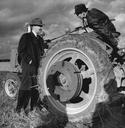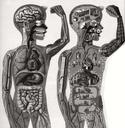Rachel Carson is widely known as a seminal voice in the development of grassroots environmental movements and an inspiration for environmental activism. The 1962 publication of her ground-breaking book, Silent Spring, changed the course of sociological and environmental history not only in America and Europe, but indeed, throughout the world, through its translation into nearly 30 languages. In Silent Spring, Carson pointed out the harmful consequences for public health and the environment of the indiscriminate use of DDT. The success of the book was based upon a meticulously researched compilation of evidence documenting the danger of its use, conveyed in a compelling literary style that rendered scientific language accessible to a general public. In Silent Spring, Carson questioned the limits of technology, exposed the risks of DDT due to a lack of normative precaution, and urged her readers to recover the deep relation between man and nature as an urgent, if unrealized, social issue. As an early biographer of Carson has put it, “Eight years after its publication, an editorial writer remarked: ‘A few thousand words from her, and the world took a new direction.’”[1]
But it was another book, a comparatively “little” essay—“the wonder book,” as Carson once called it—which was dearest to her heart, a personal credo. Taking its place alongside Silent Spring as among Carson’s most recognized texts, The Sense of Wonder has inspired environmental educators and conservationists, scientists and ecologically-concerned citizens, for decades; however, its importance for religious communities, its consonance with the Church’s teachings on the integral development of the person―indeed, an integral ecology―is what the authors of this review wish to emphasize. It is our hope that, upon reading “the wonder book,” the profound significance of this quiet woman’s legacy to all people of goodwill will become evident.
In a 1954 address to the Sorority of Women Journalists, Carson offered a statement of the “creed” underlying the “preoccupation with the wonder and beauty of the earth [that] has strongly influenced the course of my life.”[2]
I am not afraid of being thought a sentimentalist when I stand here tonight and tell you that I believe natural beauty has a necessary place in the spiritual development of any individual or any society. I believe that whenever we destroy beauty, or whenever we substitute something man-made and artificial for a natural feature of the earth, we have retarded some part of man’s spiritual growth.... [T]here is in us a deeply seated response to the natural universe, which is part of our humanity.
The book The Sense of Wonder was originally an article commissioned by the magazine Woman's Home Companion entitled “Help Your Child to Wonder” (1956), and was published posthumously in 1965 by Harper & Row. Carson ardently hoped to expand this essay into a book before her death, considering it the heart of her legacy. But she did not live to develop the essay as she wished, her health rapidly weakening, and her remaining time and energy under unrelenting assault by the controversy aroused by the publication of Silent Spring (aggressively spearheaded by the petrochemical industry). She died of metastatic breast cancer at age 56, an intensely private and humble woman thrust into the very public storm of Silent Spring’s advent, but this, ultimately, in service to the beauty and wonder that had sustained her life.
The Sense of Wonder is a book of reflections and experiences inspired by Carson’s own devotion to sharing nature with children. Upon the death of her sister, she adopted her young nephew, Roger. Rachel, who never married or had children, delighted in sharing what she loved most with the little boy, the birdsong-filled forests and the rocky beaches of her beloved home in Maine. When Roger was only 20 months old, they began their adventures together. The simple and enthusiastic “welcome” of the experience of nature by the baby captivated Carson. The force of the waves, the noise of the wind, the smell of the sea, the darkness of the night, produced not fear in the child, but quite the opposite:
One stormy autumn night when my nephew Roger was about twenty months old I wrapped him in a blanket and carried him down to the beach in the rainy darkness. Out there, just at the edge of where-we-couldn’t-see, big waves were thundering in, dimly seen white shapes that boomed and shouted and threw great handfuls of froth at us. Together we laughed for pure joy—he a baby meeting for the first time the wild tumult of Oceanus, I with the salt of half a lifetime of sea love in me. But I think we felt the same spine-tingling response to the vast, roaring ocean and the wild night around us.
The ability to be amazed, Carson reminds us, is a sense that we all possess. Any of us who have been with a baby or toddler have witnessed the natural-ness of this sense. Wonder, in its innocence, draws forth curiosity, and desire to discover a world that is perceived not as foreign, but as companion. Carson recognized this early wonder as a central feature of the original developmental state through which a child must be helped to approach the world—through the loving companionship of an adult. The early experience with Roger instilled in Carson the certainty that once astonishment awakens, it becomes integral to a child’s capacity to encounter the ever-greater mystery of life itself.
It may be salutary at this point to recall that the Swiss Catholic theologian, Hans Urs von Balthasar wrote at length about the way in which a child’s exposure to the natural world, represents a kind of existential tutorial in the structure of reality, and a formation in learning to see, and learning to love. The Christian, he says, must become “cosmoform”—attuned to the mystery and beauty of nature’s forms, keeping nature as an irreplaceable “touchstone,” a source of wonder which confronts us with the glory and abundance of Being, not comprehended abstractly, but through concrete experience, as he says, of “beetles and butterflies” and the miraculous variety of nature’s forms, beginning, though, first with the mother, as Balthasar insists:
If [a child] can only become truly himself when awakened by the love of someone else, then he will become a knowing, self-comprehending, and reflecting spirit insofar as he gives himself, in love and trust, i.e. in faith, to the other person. And the more profoundly he learns through this act of surrender what existence and Being itself are, then the more [this] can create a new surrender, which is now a venturing forward in trust on the basis of experiential knowledge…. Whoever grasps this can also open himself receptively to subhuman nature and, thus, learn things from natural beings—from landscapes, plants, animals, stars—which a purely cognitive [abstract] attitude never discovers. The depth of the significant shapes of nature, the meaning of its language, the extent of its words of revelation, can only reveal themselves to one who has opened himself up receptively to them.[3]
The spiritual, developmental, and moral significance of the childhood experience of the natural world, so central to Balthasar, goes to the very heart of Carson’s life and legacy, both as writer and scientist.
A sense of the beautiful, the excitement of the new and the unknown, a feeling of sympathy, pity, admiration or love—then we wish for knowledge about the object of our emotional response. Once found, it has lasting meaning…. (56)
It is possible to compile extensive lists of creatures seen and identified without ever once having caught a breath-taking glimpse of the wonder of life. If a child asked me a question that suggested even a faint awareness of the mystery behind the arrival of a migrant sandpiper on the beach of an August morning, I would be far more pleased than by the mere fact that he knew it was a sandpiper and not a plover.(94)
Wonder is not a mere sentiment; it is the beginning of recognition. For Carson, only wonder knows. The world, that is, is known through the humble receptivity wrought by wonder. Without this, science devolves into domination. Carson’s “wonder book” carries with it, in nuce, what she warned of elsewhere: that individualistic, relativistic and technocratic thinking that transforms nature into a mere possession. For Carson, the stakes are high, for the loss of a “piety of nature” not only extinguishes the “meaning behind the mystery” we intuit in the annual arrival of a lone sandpiper traversing the shoreline on a misty evening; it threatens the theological integrity of Christianity itself and the credibility of its witness to non-believers who abide in wonder, in existential resistance to the “logic” of contemporary culture’s deformations.[4]
For Rachel Carson it was ultimately the family that was to guarantee a “piety of nature” and with it the full development of our humanity.[5] It is the mother and the father who are to help their children to wonder.
A child’s world is fresh and new, full of wonder and excitement. It is our misfortune that for most of us that clear-eyed vision, that true instinct for what is beautiful and awe-inspiring is dimmed or even lost before we reach adulthood. If I had influence with the good fairy who is supposed to preside over the christening of all children I should ask that her gift to each child in the world be a sense of wonder so indestructible that it would last throughout life as an unfailing antidote against the boredom and the disenchantments of later years, the sterile preoccupation with things that are artificial, the alienation from the sources of our strength. If a child is to keep alive his inborn sense of wonder without any such gift from the fairies, he needs the companionship of at least one adult who can share it, rediscovering with him the joy and excitement and mystery of the world we live in. (54-55)
In 2003, Pope Saint John Paul II said: “The drama of contemporary culture is the lack of interiority, the absence of contemplation.”[6] That was the visionary point of Rachel Carson, expressed in The Sense of Wonder five decades ago. That work has inspired persons of goodwill worldwide, for generations, and it is a worthy addition to the library of any Catholic who comprehends the significance of Balthasar’s warning, that “[t]he supernatural is not there in order to supply that part of our natural capacities we have failed to develop.”[7] In this regard, Rachel Carson’s “little” “wonder book” invites Catholic families to reconsider cultivating in their children a “piety of nature” through concrete experiences of nature so as to foster in children the “resilience” required in striving toward a civilization of love.
[1] Paul Brooks, Speaking for Nature: How Literary Naturalists from Henry Thoreau to Rachel Carson Have Shaped America (Boston: Houghton Mifflin Company, 1980), xvi.
[2] Rachel Carson, “The Real World Around Us,” in Lost Woods, 160, 162.
[3] Hans Urs von Balthasar, Man in History: A Theological Study (London: Sheed & Ward, 1968), 93‒94.
[4] Here we recall Benedict XVI’s discussion with priests from the Diocese of Bolzano-Bressanone, August 6, 2008.
[5] “Only as a child’s awareness and reverence for the wholeness of life are developed can his humanity to his own kind reach its full development” (Carson, Lost Woods, 194).
[6] John Paul II, “Meeting with Young People,” Air Base of Cuatro Vientos in Madrid, Saturday 3, May 2003.
[7] The Glory of the Lord: A Theological Aesthetics, vol. 1, Seeing the Form (San Francisco: Ignatius Press, 1982), 29.
Connie Lasher, Ph.D. and Maria Ángeles Martín are both Founding Members of the Instituto Laudato Si' in Granada, Spain.



